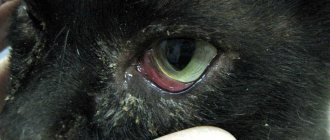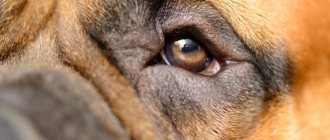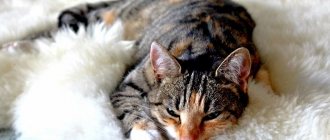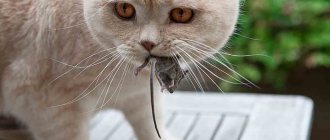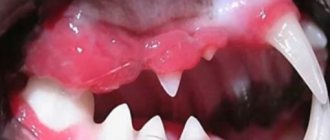Causes and symptoms of eye diseases in cats
Symptoms can be very different. An appropriate treatment must be selected for a specific disease.
Inflammation in the eyes of a cat
Entropion (etropion)
The first reason is etropion. Also called entropion. The edge of the lower eyelid bends inward, and the animal feels severe pain.
Important! If the volvulus is not treated in time, keratoconjunctivitis will develop.
Iritis (iridocyclitis)
Photophobia, yellow iris, constricted pupil are symptoms of inflammation of the iris. This disease is called iritis. Occurs due to bacterial infection, injury and metabolic disorders.
Third eyelid prolapse
The third eyelid performs a protective function. If this protective device for the cat's eyes falls out of its boundaries, then foreign bodies, viruses or bacterial infections have entered the eye. Poisoning of the body and allergic reactions occur, and nervous disorders are possible.
Cataract
When the optical areas of the lens are affected, the cat begins to show symptoms:
- lethargy;
- poor orientation;
- blindness;
- pupil dilation
Because of this, the cat becomes fearful and sometimes aggressive. The eye may become completely opaque and a cataract will appear.
Cataract on the vitreous body
Conjunctivitis
As a result of conjunctivitis, redness and swelling of the eyelid develop, and the eye begins to water. The eyelids may turn out and movement of the eyeballs may be impaired. The disease occurs due to bacteriological effects on the conjunctiva that protects the eye.
Inflammation of the third eyelid
The symptoms and causes of inflammation of the third eyelid are similar to those of prolapse. The eye begins to fester, and the kitten experiences severe discomfort.
Wounds of the eyelids
Pets may experience eyelid damage. This occurs due to mechanical damage from teeth, claws and other foreign objects that can rip off the eyelids. Inflammatory swelling and constant slight bleeding develop.
Blepharitis
Blepharitis is inflammation of the eyelids. It should not be confused with ordinary conjunctivitis. The disease most often occurs due to burns (including chemical ones), allergic reactions and mechanical damage to the cornea.
Against the background of blepharitis occurs:
- baldness around the eyes;
- the incision begins to rapidly decrease;
- redness appears;
- severe inflammation of the eyelid.
As a result, the pet's viewing angle is severely limited and disorientation appears.
Blepharitis in a cat
Adenoma of the third century
A small tumor, the size of a pea, appears in the cat's eye. Often white or bright pink in color. Benign origin does not guarantee safety, since the tumor leads to complete closure of the eye.
Dacryocystitis
The next cause of disease is inflammation of the nasolacrimal sac on the eye. A swelling appears at the site of the gland, and purulent mucous fluid often comes out of it. There is an increase in temperature and severe lacrimation.
Attention! This inflammation leads to the following problems: conjunctivitis, which provokes keratitis and a number of other diseases.
Panophthalmitis
Severe damage to the tissue of the eyeball. After staphylococci and streptococci penetrate into the eye, complete destruction of the tissues of the organ of vision from the inside develops. Within a few days, the animal’s health deteriorates sharply, and the organ begins to become severely inflamed.
Important! Appetite and sleep become poor, followed by fever and fever.
Keratitis
Inflammation of the cornea is called keratitis. The main symptom is corneal clouding of varying severity. Damage occurs due to deep eye injuries and external pathological influences
Foreign bodies entering the eye
The curiosity of cats plays a cruel joke on them. If the animal squints, blinks frequently and rubs its eye with its paw, then a foreign object is stuck in the eye. This could be dust, grass, debris, sand, etc.
Types and symptoms of conjunctivitis in cats
To figure out how to help a suffering animal, you need to understand that there are several types of conjunctivitis in cats .
- acute and chronic catarrhal;
- purulent;
- phlegmonous (parenchymatous);
- follicular;
- chlamydial.
Each form requires a specific treatment approach.
At the slightest suspicion of a disease, it is necessary to monitor the pet’s condition. In any form, there is a noticeable decrease in the activity of the animal, the clarity of the movement of the eyeballs is impaired, and photophobia manifests itself.
If the eyelids look stuck together after sleep, the hairs around the corner of the eye begin to fall out, and the discharge from there is thick and cloudy - we have an acute form.
After some time, without proper treatment, dried crusts form on the affected area, and the discharge becomes weaker, but more regular. The skin around the eye becomes inflamed and hair falls out. This means that the disease has turned into chronic conjunctivitis .
In the purulent form of the disease, a persistent unpleasant odor appears from the discharge from the eye, the pet loses appetite, the temperature rises, and the discharge itself from the affected area acquires a dirty yellowish color. Most often, purulent conjunctivitis in a cat affects both eyes, which soon swell and begin to turn red. Uncontrolled blinking is characteristic. In advanced cases, cats experience diarrhea and/or vomiting. When complications occur, the disease affects the cornea.
If, in addition to the conjunctiva itself, other areas of the eye are noticeably affected, the eyelids become very swollen, and the mucous membrane turns red, your cat has phlegmonous conjunctivitis . A distinctive feature will be bleeding of the conjunctiva when touching any area of the eye. Abrasions and tears on the dried conjunctiva are often noticeable. The disease often affects both eyes. The prognosis for the animal is unfavorable; without treatment, this form threatens blindness.
If you suspect conjunctivitis, you should pay attention to the cat's nose and throat. When the upper respiratory tract and conjunctiva become inflamed at the same time, the cat is diagnosed with chlamydial conjunctivitis . Characteristic is swelling of the conjunctiva engorged with blood and swelling near the cornea. The most severe condition in a pet occurs in the second week of the disease. The disease is caused by chlamydial bacteria, and the symptoms of the virus persist for several weeks.
Upon observation, the animal has a noticeable narrowing of the shape of the eye, profuse discharge of pus and, as a result, prolonged closure of the eyelids, photophobia, and the formation of a grayish film on the conjunctiva. Granular formations inside the eyelid are noticeable. The cat is diagnosed with follicular conjunctivitis . This form is considered extremely severe for the pet and requires immediate attention to a veterinary clinic.
Diagnosis of eye diseases in cats
Diarrhea in a cat: how to treat it at home
If this misfortune has befallen your pet, you should immediately consult a veterinarian. The organ of vision is examined and its general condition is assessed according to three parameters:
- appearance of the eyeball and surrounding tissues;
- general condition: size, shape, presence of injuries;
- state of vision.
After a superficial diagnosis, a study is carried out using special devices. The fundus of the eye is examined, the sensitivity of the microflora to antibiotics is determined, and the pressure inside is measured. A specialist may prescribe a biochemical blood and urine test.
Fundus examination by a veterinarian
Eye inflammation in a cat: how to treat it at home
Third eyelid in a cat: causes, treatment at home
If the disease has not passed the irreversible stage, then treatment of eye inflammation in a cat at home is carried out conservatively. Antibacterial eye ointments and drops are used. Damaged organs of vision should be thoroughly rinsed with a weak solution of furatsilin before treatment.
The most popular substances found in ointments and drops:
- Erythromycin,
- Gentamicin,
- Tetracycline,
- Levomycetin.
Surgical intervention is resorted to in advanced cases of serious illnesses, for example, with panophthalmitis, this is the only method of treatment. The success of vision preservation depends on timely and correct diagnosis.
Why does my cat have pus in his eyes?
The factors that provoke the appearance of pus from the eyes against the background of inflammation are quite extensive. Inflammatory processes in the area of the conjunctiva of the eye that are not detected in a timely manner are of great importance. Incorrect therapy or its absence leads to the development of chronic pathologies.
The acute form of the disease often takes a severe turn, turning into purulent forms of pathologies. This may be follicular or parenchymal conjunctivitis, accompanied by depression of the general condition of the animal and painful sensations in the eye area. If left untreated, the disease can lead to serious complications.
The causes of inflammation in the eyes are various injuries and bruises received by the animal. As soon as the inflammation moves to the area of the eyeball, increased secretion of tear secretion occurs, and when pathogenic bacterial microflora joins, pus appears.
An animal can get an eye injury during clashes with relatives or when bumping into sharp objects during active games. Any mechanical damage to the delicate conjunctiva leads to changes.
Inflammation as a result of severe irritation of the conjunctival membrane is also provoked by foreign objects entering the eye. A particular danger is that inflammatory processes also affect the sclera of the eye and the cornea. In turn, this provokes open access for the penetration, activation and development of pathogenic microorganisms, provoking the appearance of purulent exudate.
The cause of the appearance of pus from the eyes of a cat is also blepharitis, which occurs against the background of mechanical damage, as well as chemical or thermal burns. Against the background of weakening of natural defenses, pyogenic microflora penetrates the membranes and leads to the development of the inflammatory process. Infection occurs not only with bacteria. Fungi and viruses can take part in the development of inflammation.
Another type of pathology that provokes the appearance of purulent exudate is keratitis (inflammation of the corneal layer). Depending on the factors that provoked the appearance of inflammation, the nature of the purulent exudate and symptoms vary. Signs of major diseases affecting the cat's eye:
- Bruises of the eyelids - characterized by the appearance of bruising. Crushing of tissue structures close to the eyelid cannot be ruled out. In some cases, necrosis (tissue death) is diagnosed. There is pronounced swelling in the affected area, an increase in local temperature and pain.
- Open wounds - they are characterized by bleeding against the background of gaping, severe pain.
- Blepharitis is an inflammatory process, in the initial stages characterized by severe itching and hyperemia of the eyelid margins. Swelling develops. The animal constantly tries to scratch its eye, provoking infection and aggravating the course of the pathology. In the vast majority of clinical cases of diagnosed blepharitis, the cause of pus from the eyes is the addition of staphylococcal and streptococcal infections.
- Conjunctivitis is an inflammatory process that, in the absence of timely treatment, leads to an increase in local temperature, pain and the appearance of purulent exudate. At the initial stages, the pus is liquid, but over time it becomes thick. There may be the development of follicular conjunctivitis, characterized by damage to the lymph nodes located in the area of the inner part of the third eyelid. The animal has swelling of the eyelids, pain and photophobia (fear of light).
- Chlamydia is an infectious disease that often affects domestic cats and quickly becomes chronic. One of the first signs of pathology is the appearance of pus from the cat’s eyes.
- An allergic reaction - manifests itself in response to certain medications, foods and feeds, animal care products (soap or shampoos) and household chemicals with which the animal comes into contact. In addition to profuse lacrimation, the cat may experience mucous discharge from the nasal passages and may sneeze or cough. The pet's condition is aggravated by the fact that the immune defense is reduced. Bacterial infections often occur against the background of allergies, causing the development of purulent inflammation in the eye area.
As soon as the owner of the animal notices the following signs, it is necessary to seek help from a veterinary hospital:
- discharge of pus from the eyes, accompanied by gluing of eyelashes;
- the appearance of crusts that prevent the eye from opening normally;
- eyelash loss;
- inflammation under the eye, hair loss;
- development of dermatitis and eczema on the face in the eye area.
Eye wash
Cystitis in a cat: symptoms and treatment at home
The washing procedure itself does not require special skills and knowledge, but you should consult a veterinarian about the product. Otherwise, the condition will only worsen, and this will lead to the progression of the disease. Often use regular saline solution, boric acid or herbal decoctions.
Washing the cat's eyes
Healthy! You can buy ready-made solutions in pharmacies.
The best drugs for treatment
For treatment to be as effective as possible, you need to choose proven means.
Iris
Gentamicin is the active substance in the composition. Kills anaerobic and protozoan bacteria. Prescribed for conjunctivitis, keratitis, blepharitis and corneal erosion. Instilled under the conjunctiva 4 times a day. Course duration – 7 days. Cost: 150 rubles.
Leopard
Chloramphenicol and nitrofural destroy bacteria, microorganisms and viruses. Prescribed to prevent the development of infections due to mechanical damage, for the treatment of acute and chronic forms of conjunctivitis. Before use, clear the eye of purulent discharge, course – 1.5 weeks. Cost: 80 rubles per bottle.
Levomycetin
Antibiotic. Eliminates any infectious agents. Has a wide range of applications:
- blepharitis;
- keratitis;
- infected injuries to the eye area;
- any types and stages of conjunctivitis.
Drop onto the eye 3 times a day. The course of treatment is 5-7 days. Can cause side effects - burning, redness of the eyeball. Price: 10-15 rubles.
Prevention of eye diseases
To prevent your cat from having eye problems, you need to eliminate all the factors that lead to diseases. It is necessary to wash the cat's organs of vision with saline solution so that there is no excess secretion there. Carry out wet cleaning every day, otherwise the animal may get a foreign body that can inflame the eye. You can't disturb the cat, then it will be healthy.
There are many eye diseases in cats, so pets should not be stressed and need regular care. If you do everything correctly and love your animal, then no disease is scary.
*Prices are current as of September 2021.
Prevention measures
Do not forget that cats have excellent eyesight and the loss of it can be a huge loss for her. By carefully and carefully caring for your cat's eyes, you can avoid many unpleasant consequences.
Light adhesions observed in the morning and any secretions released do not mean the presence of the disease. The Persian breed has this distinctive feature, and older individuals at that.
Sometimes the color and intensity of the discharge is also affected by the animal’s diet: mixing dry and homemade food at the same time or throughout the day. Perhaps your cat has allergies or there are unwanted “guests” in her body - worms.
You need to start sounding the alarm if various kinds of redness, swelling, cloudiness, and pus appear. To avoid eye sores, do not forget to perform a set of caring actions every morning:
- Daily removal of accumulated dirt from natural secretions using a solution purchased in a specialized store or boric acid (2% aqueous solution), tea leaves, or simply clean boiled water. Chamomile is not recommended for constant use.
- Lubricate the damaged area around the eye with Vaseline or appropriate ointment.
- Cleansing movements are carried out from the outer corners of the eyes to the inner ones, not forgetting the fur near them. To do this, use a disposable cotton swab.

